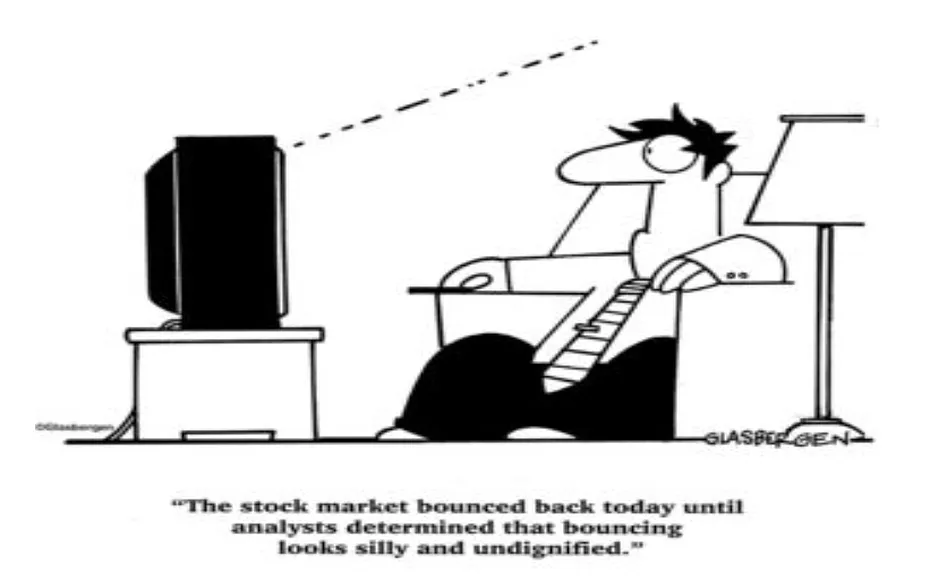Summary
In a world craving order amid randomness, we often fall for neat investment stories that seem logical but mask reality. This piece explores the “narrative fallacy” - our tendency to believe compelling but misleading explanations - and offers ways to protect against letting emotional storytelling cloud rational investment decisions.
The world is an uncertain place. A country’s economy grows at 7% and yet the stock market crashes. A company you’ve never heard of suddenly becomes a 20-bagger, and another you followed religiously disappears. Interest rates rise, but the markets rally. Crude oil falls, and inflation doesn’t move. Predictions fail, but still new ones are made with remarkable confidence.
Despite this randomness, and maybe because of this, we are constantly in search for order. We tell ourselves, “There must be a reason.” And when we can’t find one, we make one up.
So, we make up “stories” or narratives that connect the dots, even when the dots were never meant to be connected. And we do this because such narratives feel like acts of self-reassurance that “all is well.”
Nowhere is this tendency more evident, and more dangerous, than in the way we invest.
Every investor, no matter how rational they believe themselves to be, has at some point fallen in love with a story. A clean, confident narrative that connects all the dots, things like past success, present growth, and future market leadership.
- “The founder has vision.”
- “The product has potential.”
- “The sector is booming.”
- “The world is changing, and this company is riding that wave.”
- “This time is different.”
But step back for a moment, and ask: Is this investing? Or is it wishful storytelling dressed up in well-made charts and well-meaning characters?
The term for this tendency is narrative fallacy, which is a cognitive bias that causes us to overvalue explanations that are coherent, emotionally appealing, and easy to remember, while undervaluing the contradictory nature of reality.
In his book, Black Swan, where he describes narrative fallacy in detail, Nassim Taleb writes -
It is actually a fraud, but, to be more polite, I will call it a fallacy. The fallacy is associated with our vulnerability to overinterpretation and our predilection to compact stories over raw truths. It severely distorts our mental representation of the world; it is particularly acute when it comes to the rare event.
So, we iron out the rough edges of what actually happened to create clean cause-and-effect stories that feel right, even if they aren’t entirely true. All we need to prove this bias exists is to look back at any investment we’ve made and try to explain, after the fact,why it went up or down.
Switch on any financial news channel around market close, and within seconds, someone well-dressed will confidently explain why the market moved the way it did. “Markets ended higher today after strong earnings from tech giants.” Or, “Markets slipped on fears of rising interest rates.” It sounds precise and neatly packaged, as if the day’s market movement had a clear cause. Rarely is it that simple. But our minds crave simplicity, and stories give it to us.

Daniel Kahneman wrote in Thinking, Fast and Slow:
Flawed stories of the past shape our views of the world and our expectations for the future. Narrative fallacies arise inevitably from our continuous attempt to make sense of the world. The explanatory stories that people find compelling are simple; are concrete rather than abstract; assign a larger role to talent, stupidity, and intentions than to luck; and focus on a few striking events that happened rather than on the countless events that failed to happen. Any recent salient event is a candidate to become the kernel of a causal narrative.
Kahneman, who coined many of the mental models we now use to understand bias, explains that humans are not built to deal well with randomness. We crave order and patterns. And when those patterns don’t exist, we create them. That’s what stories do. They offer the illusion of understanding.
In investing, that illusion can be costly. What begins as a basic idea, say, a company operating in a fast-growing sector (EVs, solar, fintech, edutech, AI, etc.), can quickly morph into a grand vision.
We start to assign narratives like “disruption” and “transformation.” These words carry emotional weight. They also carry risk, because they demand less scrutiny. A powerful narrative has the unique ability to make us stop questioning. We want the story to be true, so we bend the facts until they fit.
Behavioural research supports this tendency. Studies in cognitive psychology have shown that people are more likely to believe and remember information when it’s embedded in a story rather than in abstract data. Neuroscience reveals that storytelling activates more regions of the brain than factual presentation alone. It literally feels better to process a story than raw numbers.
Robert Shiller, the Nobel-winning economist, refers to this as “narrative economics”, which he defined as the idea that stories themselves move markets, not just fundamentals. In other words, we don’t just respond to data, but to the way the data is told.
Now, there’s also an emotional component that complicates things. When we believe in a story, we feel a sense of control and clarity. We imagine future headlines. We picture ourselves as early believers in something big. That anticipation of being right and of spotting the next big winner produces a dopamine hit. It’s intoxicating. But this emotional engagement also clouds judgement. It becomes harder to see risks, to accept that the story might not play out, and to sell when the facts change.
And so we end up justifying and rationalising.
We find other believers and form echo chambers. We say things like, “It’s a long-term play,” or “Markets just don’t get it yet.”
We use valuation as a flexible tool. So, if the stock price falls, it’s “a buying opportunity.” If it rises, “we were right all along.”
At no point do we question the integrity of the original narrative, because by then, we’ve tied it to our identity. It’s now not just a story about a company but a story about us being smart and wise.
But reality doesn’t care about coherence. It doesn’t move in straight lines. And a lot of stories have a sad ending. Businesses falter. Competition arrives. Demand shifts. Promoters change direction. And the narrative that once felt so clear suddenly doesn’t explain what’s going on.
And now we’re stuck because we didn’t prepare for the possibility that the story was never the full truth. We are now like that emperor with no clothes.
Now, this doesn’t mean all stories are bad. Stories help us remember key lessons (like Buffett using an Aesop fable to explain DCF). Stories help us teach. Even the best investors use narrative to frame their thinking. But the crucial difference is that they start with substance and let the story emerge from facts, not the other way around.
In contrast, the narrative fallacy begins with belief and retrofits the facts. That’s the danger.
How to Protect Against Narrative Fallacy?
We are humans, and the mind is what it is. But the reason we want to learn about the holes (biases) in our minds is that we can then learn to minimise the mistakes that get other people (who don’t understand such biases) into problems.
And so, it’s important to look for ways to protect ourselves against, well, ourselves. That also holds true for the need to protect ourselves against the narrative fallacy.
One of the ways to do that is by becoming aware of how often we’re drawn to simplicity. When something feels too neat, too exciting, or too certain, that’s usually a red flag. Businesses are complex, but if the management’s narrative sounds like a TED talk, pause and look again.
Second, learn to separate the story from the numbers. Look at cash flows. Look at capital allocation. Look at what the company actually does, and not just what it says it will do. Ask yourself: would I be interested in this business if I had no management narrative but just the financials?
Third, pay close attention to how the story is spreading. Is it being told by objective and experienced analysts and investors or by social media influencers with a stake in the game? Is the story consistent over time, or constantly shifting to fit new developments? Remember that when stories evolve faster than earnings, something is off.
Fourth, invert the story. Play devil’s advocate. Ask: If this turns out to be a poor investment, why might that happen? Also ask: What are the blind spots I’m ignoring? This kind of reflective thinking should help you ground the story in reality.
And finally, ask yourself this uncomfortable but important question: Am I holding this stock because of what the business is doing, or because of what I want the story to become? That distinction is often the line between rational investing and emotional attachment.
In the end, the stock market is not a book of well-told stories or fairy tales, but a place where capital meets uncertainty. And while stories will always be part of how we process the world, we must resist the urge to treat them as fact.
Investing requires both imagination and discipline. It’s okay to admire the narrative. But we must invest in the business, not what the stories tell it is.
This is because when the music stops and reality shows up, we won’t be left holding a great story. We’ll be left holding the consequences of having mistaken one for truth.
Industry insights you wouldn't want to miss out on.
Written by
Disclaimer
This is an investor education and awareness initiative by DSP Mutual Fund. All Mutual fund investors have to go through a one time KYC (Know Your Customer) process. Investors should deal only with Registered Mutual Funds (‘RMF’). For more info on KYC, RMF and procedure to lodge/ redress any complaints visit dspim.com/IEID. For SMART Online Dispute Resolution portal, visit link https://smartodr.in/login
All content on this blog is the intellectual property of DSPAMC. The User of this Site may download materials, data etc. displayed on the Site for non-commercial or personal use only. Usage of or reference to the content of this page requires proper credit and citation, including linking back to the original post. Unauthorized copying or reproducing content without attribution may result in legal action. The User undertakes to comply and be bound by all applicable laws and statutory requirements in India.
Mutual Fund investments are subject to market risks, read all scheme related documents carefully.
 Account Statement
Account Statement  Capital Gain Statement
Capital Gain Statement  Key Information Memorandum
Key Information Memorandum  PAN Updation
PAN Updation  Register / Modify KYC Online
Register / Modify KYC Online  Nominee Registration
Nominee Registration  Email / Phone Updation
Email / Phone Updation  OTM / eNACH Registration
OTM / eNACH Registration  Guidelines for Incapacitated Investors
Guidelines for Incapacitated Investors  FAQs
FAQs Reach us
Reach us
















Write a comment